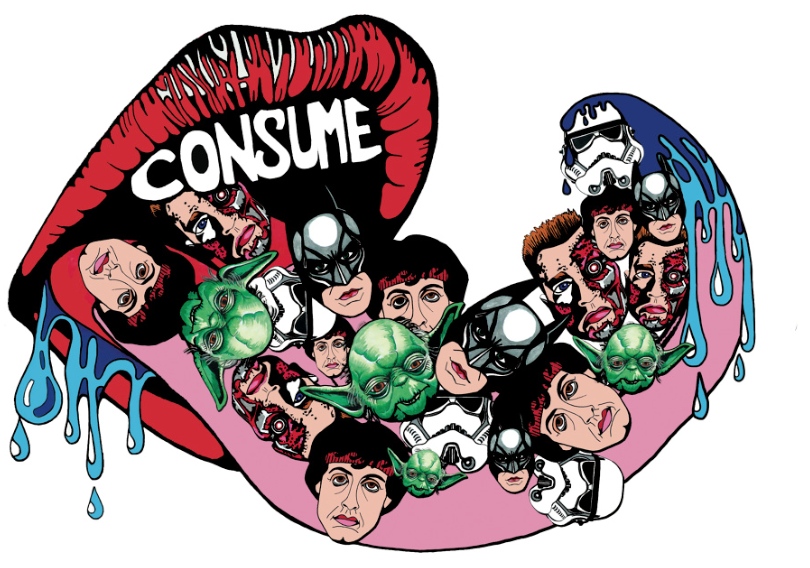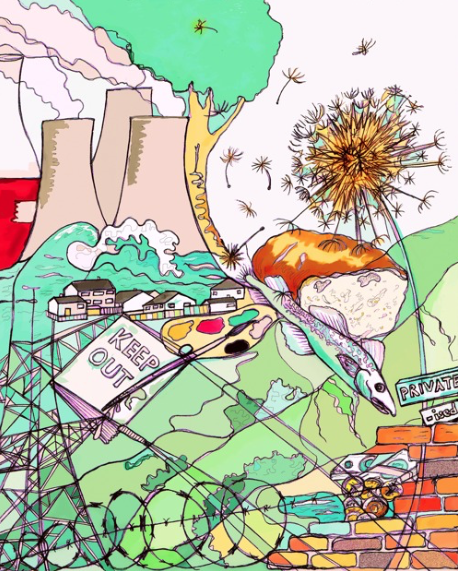Alternative Editorial: Accelerating Convergence
All images from Stir To Action Magazine illustrations. Above by Matthew Brazier
Field 725 in Frome, Somerset, saw a bit of a tribal gathering this week. I use the term carefully, because there were many previously disconnected groups within this emerging frame who might not relate as a tribe. Maybe more like extended family.
Cooperatives shared space with with restorative practices. Political initiatives (Flatpack Democracy to Joe Guinon’s plan for the first 100 days for a Labour Government) shared space with embedded community relationship practitioners, Loomio. Established institutions like the NEF went alongside imagination-warriors.
Yet their message was largely coherent. We champion connectedness, communities and human potential. And we can see the multiple crises we are in.
STA illustration by germanioelemento
So it was very helpful that the gathering was called Stir To Action (STA). No matter how absorbing your personal focus of attention, there was always a bigger call to make it about what we can do, concretely and collectively, to meet this difficult moment. Many of the co-creators of CtrlShift were there, helping to frame all that was happening as part of a bigger picture: that is, how we practically shift power from Westminster to people in their communities.
But also attending and speaking were regulars from the Burning Man, Enspiral and Findhorn communities. Their emphasis was on healing internal disconnections – which means relocating the power to welcome and include whatever is alienated on the inside of each individual.
In the midst of all this joyful and mutual recognition – and kudos to Jonathan Gordon-Fairley for curating such an eclectic mix – three observations and consequent questions came to mind.
Firstly, many good conversations were had over delicious food, but there was no whole-festival exploration. How can this interesting mix of people talk better to each other so that collaboration is the result? How can we change the system, if we don’t do work on our own system? The culture of mainstage versus small stage seemed a bit old-school, especially when the fullest participation happened only on the furthest reaches of the festival grounds. Next year, I would suggest a full-on constellation work shop or Social Presencing Theatre both on the first and the final day, next year.
Secondly, this was “small is beautiful” made manifest - but it was small. How does this grow in numbers and therefore energy? Seeing so many leaders of movements at the festival – Transition Towns, Cooperative Movement, Flatpack Democracy, New Municipalism, New Economy, Decentralising Technology – what would it take to bring all of their movements’ members into a space we all share (both real-life and virtual)? Could this be what XR is beginning to think about as the movement of movements?
STA illustration by Gemma Cotterrell
Thirdly, it was delightful to meet so many people who agree with each other, often at a very deep level. Yet the challenge is: how do these ideas become part of a more mainstream narrative? One that would speak to the millions, indeed billions of people we need to get on side in order to save (or save us from) the planet? I don’t think that means trying to change our language to something that would feel appropriate to the Daily Mail. I believe the popular media would work out their own version of the ideas at this festival, once they could see how what we are doing is popular with their own biggest audience – which is women.
Even as I am writing this, I feel somewhat surprised to be naming that factor, amongst all the other factors that would shift our actions to another level. Stir To Action did well, platforming almost as many women as men on each of their stages. At another level, I had more than one conversation in the course of the three days, that brought home how much of the feminine was in that space: men as well as women championing what have been traditional femme values. Such as relationship, empathy, family, community.
Yet there is still something quite male in what counts as action. Are we only in action when we build institutions, take over the government, build a network, establish the new economy and create new jobs? The hard-power actions that capture and organise community energy? Scaling it up to what is understood as meaningful proportions? Joe Guinan’s book ‘People Get Ready’, launched at the festival, offers a clear schedule for the first 100 days of a Corbyn government (without such a hard-headed programme, apparently, it may fail).
Or are we in action when we individually start to wake up to our own response-ability in transforming the future? One challenging workshop, held by Culture Garden led us into an impossibly difficult task which I’ll share here. “In what order would you agree to sell the following: Sperm, babies, your vote, sex?” Although we were in a beautiful woodland copse, the workshop was loud and disputatious, with some of the qualities of the Brexit debate.
Although each group was given the chance to present their conclusions, few of them could come to agreement and a number of people walked away. At which point Facilitation Director Madelanne Rust-D'Eye invited us to check our internal body states, and notice how and where our frustration was located.
Some reported it as a pain in their solar plexus. Another as an ache in their arms, framing their body and holding them rigid. That visceral reality – where we are physically vulnerable when faced with conflict - explains something about why we tend to avoid it. We prefer others to take it on, on our behalf.
When we acknowledge that lack of “response ability” and begin the practices of becoming stronger and more capacious on the inside – isn’t that a form of action? One of the great virtues of this event is that it allowed two fronts to be opened up about the impact of a “new economics” of people’s lives – that is, both internal and external, psychological and social.
There were enough examples here – from neighbourhood pubs to new community banks, from digital participation to Preston food coops – of forms of production and services that are less alienating, more in the control of workers and consumers. And by these means, the hidden injuries caused by the aggressive capitalisms of recent times might be healed.
Yet “good work” only partially does the healing. And does little to address the crises we experience both in our communities and on the planet. That work needs its own focus, is in itself a set of actions. Without that, communities will still be controlled by the injustices of the past and not be in a position to participate fully in the solutions.
STA Illustration Sam Parr
Extinction Rebellion’s success in bringing communities a new common ground for everyone to meet each other around a clear goal, could hardly have been imagined by political parties. Where every scientific assessment of the current state of affairs makes clear priorities. That those privileged enough to fly, drive and consume unthinkingly must do more, give up more than others to help us get back on track to a healthy environment. Who could have imagined such a leveller?
Can visions of a good life, brewed up in these circumstances, begin to suggest new forms of economics than just the “decent job”? Might these newly identified and shared struggles (over, say, parenting, food, the built environment) mean that new alliances could be formed, across old divides? Could a degree of self-development, or “response ability”, on all sides help those alliances happen?
Given that self-development was the biggest publishing phenomenon of the late 20th Century and continues to be an enormous attractor in the age of social media, it might be a clue to how we bring in more of the mainstream. While it’s easy to think of programmes like Big Brother or Love Island as shamelessly amplifying our sexist, consumerist public space, it’s also interesting to note how they are training young people to observe and critique behaviour.
How they draw attention to the issues of consent, body shaming, bullying, gas-lighting – all forms of power-mongering. If you doubt that, chat with your kids and note how much more emotionally and socially literate they are than we might have been at a similar age.
In another part of the mediascape, endless programmes about taking on impossible tasks, facing disappointment, learning how to collaborate, making the impossible, possible. Who is the Kirsty Alssopp of green, co-housing solutions? Or the glittering prize for successful carbon reduction?
For now, at Stir To Action, it was mostly institutional action that warranted the mainstage and individual actions that claimed the next two levels. There was one notable exception. Rob Hopkins introduced his new book on the imagination ‘From What is to What If’: Unleashing the power of imagination to create the future we want’.
Founder and figurehead of the Transition Town movement since 2005 (and much covered here), Rob took some time off to explore what’s next. This book is a series of conversations with people who have unleashed the power of their imagination to create radically new realities for their towns and communities.
But instead of offering blue-prints or prototypes of their success stories, Rob brings it down to the use of something we all have in spades – imagination. It’s a profoundly democratising action, giving people their own entry point into the bigger picture of transformation by institution building.
It’s imagination that we draw on in Stage 2 of our collaboratories, the “Inquiry” when we invite participants to re-imagine the future together – below and across the divisions created by our current politics. What we’ve learnt in the process is maybe some of what was being offered in the smaller tents at STA. This is also what A/UK’s co-initiator, Pat Kane described in his book The Play Ethic as “the creative conditions for a fuller democracy”.
For all kinds of people to freely use their imaginations and bring them into play, we need the inner capacities and outer conditions of security. Only then can historically disempowered citizens begin to participate fully in building the future. For more on this, read these pieces on Universal Basic Income and Bildung – whole person education – and more from Pat here.
One way or another, many of the elements of a transformed society were present and relating on Field 725 in Frome, Somerset. The atmosphere was warm, friendly and vital. As we enter into our make-or-break decade in 2020, let’s see in what ways we were Stirred To Action.





